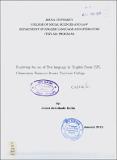| dc.description.abstract | There has been an age old debate on whether to use the students' first language in a foreign language classroom or not among teachers and educators (Brown, 2000). L1 opponents argue against its use because they believe that it reduces learners' L2 exposure while those in favor of it claim that judicious use of L1 facilitates L2 learning. The researches carried out so far validated the judicious use of Ll to be facilitative. Inspired by this, the present study set out to examine 'English Focus' students' and their EFL teachers' use of Oromo language in the EFL classrooms of Jimma Teachers college. To this end, a mixed research method involving quantitative and qualitative methods of data collection was employed. The study was conducted on 78 representative students drawn from r', 2nd and 3rd year 'English Focus' total student population and six EFL teachers of Jimma Teachers college. In order to investigate the use of Oromo language (L 1) in EFL classrooms, distinct questionnaires addressing students and their EFL teachers were developed and employed as a major tool to assess issues like L1 presence, preferred amount, purposes for which it is used, the attitudes of students and teachers toward L1 use and others. Furthermore, open-ended interview to the teachers and classroom observations were used as supplementary data collecting tools.
The results revealed that Oromo language was used in college 'English Focus' EFL classrooms for various functions and the attitudes of the students and teachers about using Oromo were also generally positive. In spite of few functions for which students felt the use of Ll was inappropriate, teachers and students were in most cases in agreement about when L1 should be used or when a teacher should use Ll. It was also confirmed that the students' preferred amount of Ll varied from year of study to year of study. First year students claimed 5.5-7.5 minutes or 11-15% out of L2 class time while Second years' claim was 3-5 minutes or 6-10%. The least amount (less than 2.5 minutes or <5% out of L2 class time) was claimed by Third year students. What's more, statistically significant difference was found between the attitudes of first year and
third year students. Their Ll need went on dropping as their L2 experience increased with the stay at the college. Similarly, male and female students in the categories were also found to have statistically significant differences in their attitudes toward EFL classroom Ll use. Ll use in L2 classroom does mean a lot to female students than male students. Overall findings do indicate possible support for the use of Ll in the L2 classroom. | en |


